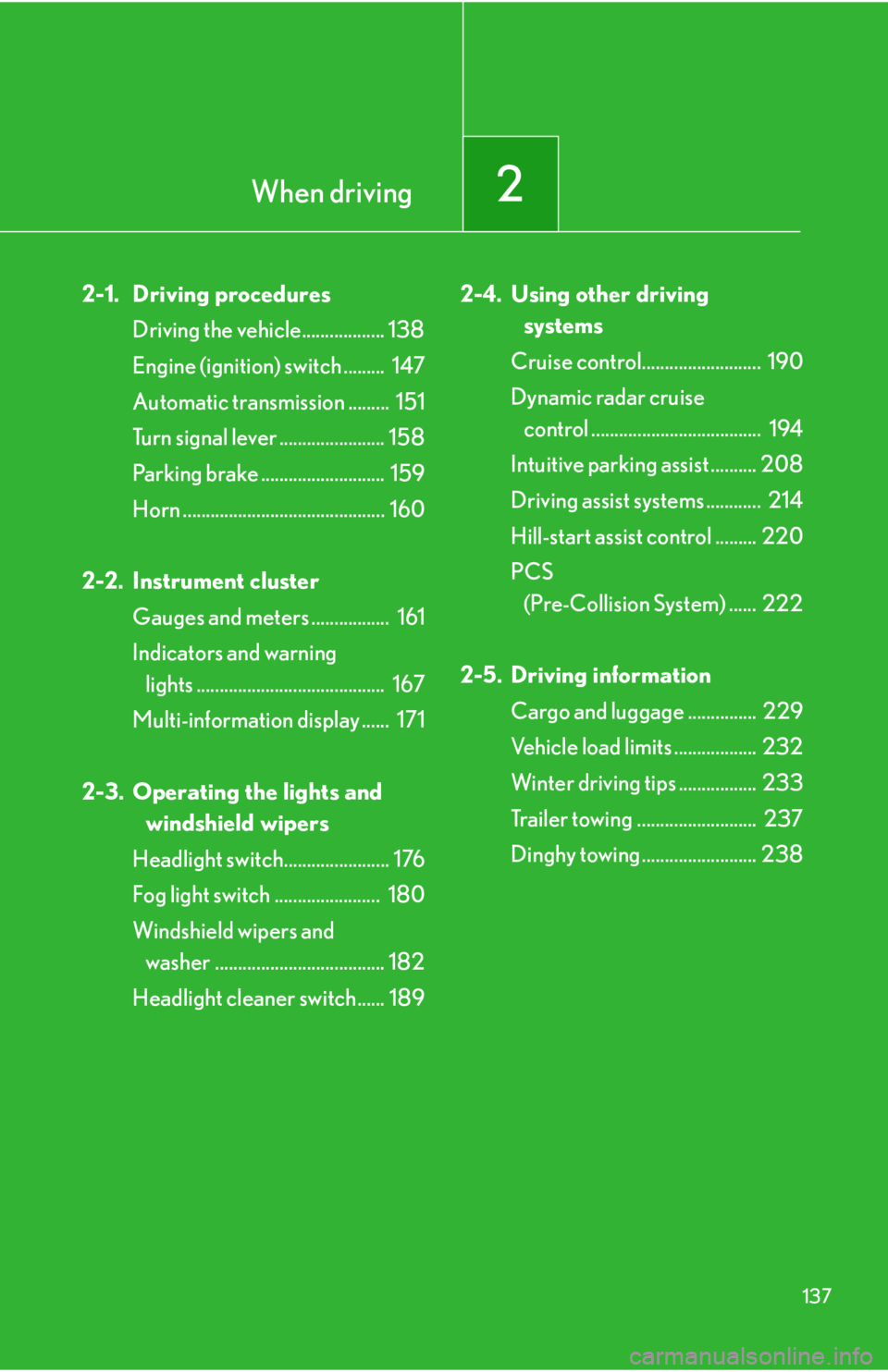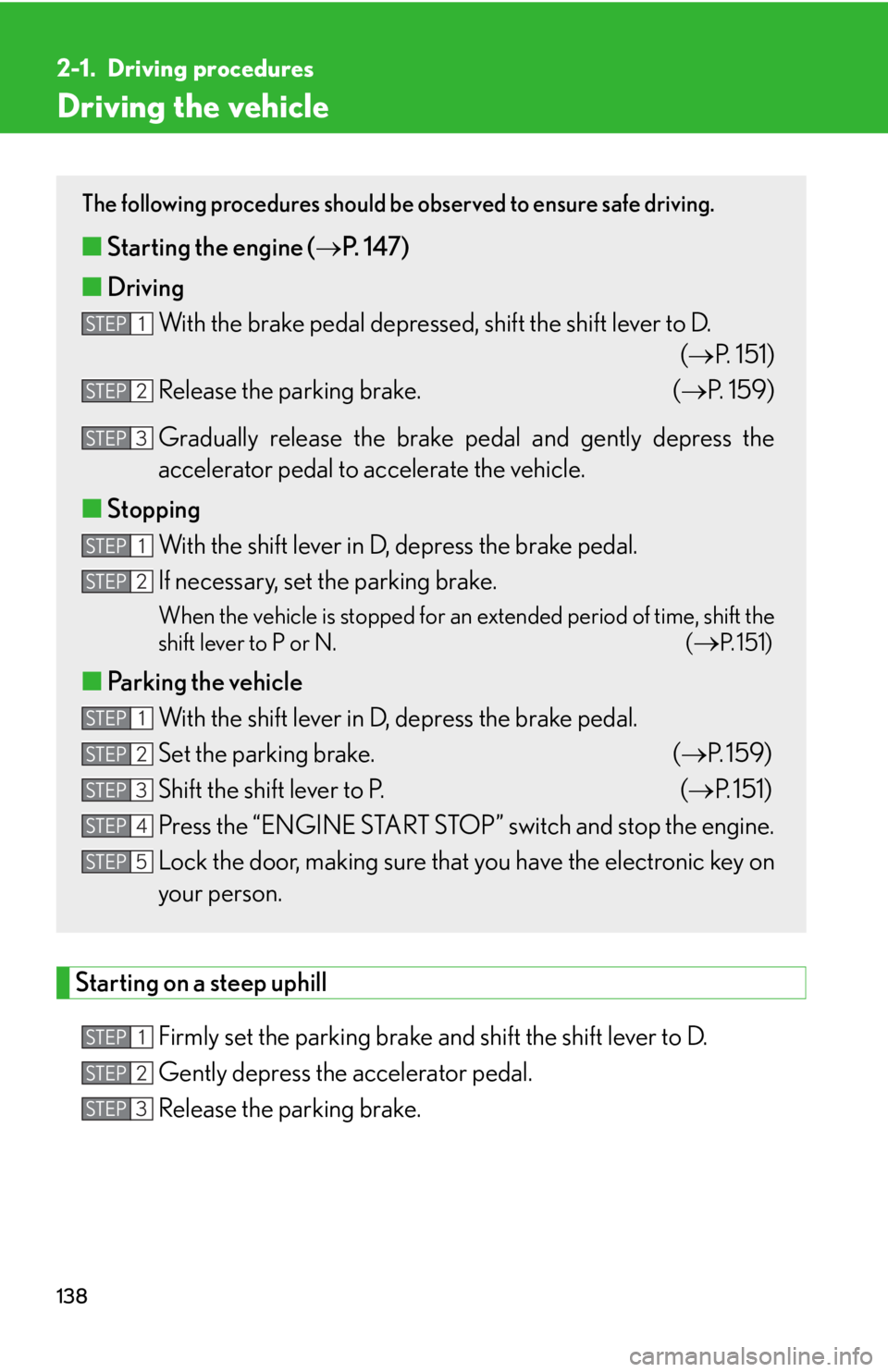LEXUS IS250C 2013 Owners Manual
Manufacturer: LEXUS, Model Year: 2013, Model line: IS250C, Model: LEXUS IS250C 2013Pages: 624, PDF Size: 6.58 MB
Page 131 of 624

131
1-7. Safety information
1
Before driving
While pushing the child seat into
the rear seat, allow the shoulder
belt to retract until the child seat is
securely in place.
After the shoulder belt has
retracted to a point where there is
no slack in the belt, pull the belt to
check that it cannot be extended.
If the child restraint has a top tether strap, the top tether strap
should be latched onto the top tether strap anchors.
■ Booster seat
Place the booster seat on the seat
facing the front of the vehicle.
Sit the child in the booster seat. Fit
the seat belt to the booster seat
according to the manufacturer's
instructions and insert the plate
into the buckle. Make sure that the
belt is not twisted.
Check that the shoulder belt is cor-
rectly positioned over the child's
shoulder, and that the lap belt is as
low as possible. (
P. 7 0)
STEP4
STEP5
STEP1
STEP2
Page 132 of 624

132
1-7. Safety information
Removing a child restraint installed with a seat beltPush the buckle release button
and fully retract the seat belt.
Child restraint systems with a top tether strapSecure the child restraint using a
seat belt or the lower anchors.
STEP1
Page 133 of 624

133
1-7. Safety information
1
Before driving
Pass the end of the top tether strap
through the gap between the seat
and the head restraint. Fold the
head restraint forward into the
stowed position. (P. 67) Open
the anchor bracket cover, latch the
hook onto the anchor bracket and
tighten the top tether strap. Return
the head restraint to the upright
position.
Make sure the top tether strap is
securely latched.
Close the anchor bracket cover
after install the child restraint sys-
tem.
STEP2
■When installing a child restraint system with lower anchors and a top tether strap
Depending on the child restra int system's size and shape, if the child restraint sys-
tem is installed to the LATCH anchors first, it may not be possible to attach the top
tether strap to the anchor bracket.
In that case, first temporarily attach the top tether strap to the anchor bracket, install
the child restraint system using the lowe r anchors and then tighten the top tether
strap.
■Laws and regulations pertaining to anchorages
The LATCH system conforms to FMVSS225 or CMVSS210.2.
Child restraint systems co nforming to FMVSS213 or CMVSS213 specifications
can be used.
This vehicle is designed to conform to the SAE J1819.
Page 134 of 624

134
1-7. Safety information
CAUTION
■When installing a booster seat
Do not fully extend the shoulder belt to prevent the belt from going to ALR lock
mode: ( P. 7 2 )
ALR mode causes the belt to tighten only which could cause injury or discomfort to
the child.
■When installing a child restraint system
Follow the directions given in the child restraint system installation manual and fix
the child restraint system securely in place.
If the child restraint system is not correctl y fixed in place, the child or other passen-
gers may be injured or even killed in the event of sudden braking, sudden swerving
or an accident.
●If the driver’s seat interferes with the child
restraint system and prevents it from being
attached correctly, attach the child restraint
system to the right-hand rear seat.
●Only put a forward facing child restraint
system on the front seat when unavoidable.
When installing a forward facing child
restraint system on the front passenger
seat, move the seat as far back as possible
even if the “AIR BAG OFF” indicator light is
illuminated. Failing to do so may result in
death or serious injury if the airbags deploy
(inflate).
Page 135 of 624

135
1-7. Safety information
1
Before driving
CAUTION
■When installing a child restraint system
●When a booster seat is installed, always ensure that the shoulder belt is posi-
tioned across the center of the child's shoulder. The belt should be kept away
from the child's neck, but not so that it could fall off the child's shoulder. Failing to
do so may result in death or serious inju ry in the event of sudden braking, sudden
swerving or an accident.
●Make sure the rear seat head restra ints are not in the folded position.
●Ensure that the belt and tab are securely locked and the seat belt is not twisted.
●Push and pull the child seat from side to side and forward to be sure it is secure.
●After securing a child restraint system, never adjust the seat.
●Follow all installation instructions provid ed by the child restraint system manufac-
turer.
■Do not use a seat belt extender
If a seat belt extender is used when inst alling a child restraint system, the seat belt
will not securely hold the child restraint system, which could cause death or serious
injury to the child or other passengers in the event of sudden braking, sudden
swerving or an accident.
■To correctly attach a child restraint system to the anchors
When using the LATCH anchors, be sure that there are no foreign objects around
the anchors and that the seat belt is not caught behind the child restraint. Make sure
the child restraint system is securely at tached, or it may cause death or serious
injury to the child or other passengers in the event of a sudden stop, sudden swerve
or accident.
NOTICE
■When using an anchor bracket
To avoid cover damage, be careful not to open the cover too widely.
Page 136 of 624

136
1-7. Safety information
Page 137 of 624

When driving2
137
2-1. Driving proceduresDriving the vehicle.................. 138
Engine (ignition) switch ......... 147
Automatic transmission ......... 151
Turn signal lever ....................... 158
Parking brake ........................... 159
Horn ............................................ 160
2-2. Instrument cluster Gauges and meters ................. 161
Indicators and warning lights ......................................... 167
Multi-information display ...... 171
2-3. Operating the lights and windshield wipers
Headlight switch....................... 176
Fog light switch ....................... 180
Windshield wipers and washer ..................................... 182
Headlight cleaner switch...... 189 2-4. Using other driving
systems
Cruise control.......................... 190
Dynamic radar cruise control ..................................... 194
Intuitive parking assist .......... 208
Driving assist systems ............ 214
Hill-start assist control ......... 220
PCS (Pre-Collision System) ...... 222
2-5. Driving information Cargo and luggage ............... 229
Vehicle load limits .................. 232
Winter driving tips ................. 233
Trailer towing .......................... 237
Dinghy towing ......................... 238
Page 138 of 624

138
2-1. Driving procedures
Driving the vehicle
Starting on a steep uphillFirmly set the parking brake and shift the shift lever to D.
Gently depress the accelerator pedal.
Release the parking brake.
The following procedures should be observed to ensure safe driving.
■Starting the engine ( P. 1 4 7 )
■ Driving
With the brake pedal depressed, shift the shift lever to D. (P. 1 5 1 )
Release the parking brake. ( P. 1 5 9 )
Gradually release the brake pedal and gently depress the
accelerator pedal to accelerate the vehicle.
■ Stopping
With the shift lever in D, depress the brake pedal.
If necessary, set the parking brake.
When the vehicle is stopped for an extended period of time, shift the
shift lever to P or N. (
P. 151)
■Parking the vehicle
With the shift lever in D, depress the brake pedal.
Set the parking brake. ( P. 1 5 9 )
Shift the shift lever to P. ( P. 1 5 1 )
Press the “ENGINE START STOP” switch and stop the engine.
Lock the door, making sure that you have the electronic key on
your person.
STEP1
STEP2
STEP3
STEP1
STEP2
STEP1
STEP2
STEP3
STEP4
STEP5
STEP1
STEP2
STEP3
Page 139 of 624

139
2-1. Driving procedures
2
When driving
■Starting off on a hill
Hill-start assist control will operate. (P. 2 2 0 )
■Driving in the rain
●Drive carefully when it is raining, becaus e visibility will be reduced, the windows
may become fogged-up, and the road will be slippery.
●Drive carefully when it starts to rain, be cause the road surface will be especially
slippery.
●Refrain from high speeds when driving on an expressway in the rain, because
there may be a layer of water between th e tires and the road surface, preventing
the steering and brakes from operating properly.
■Engine speed while driving
In the following conditions, the engine speed may become high while driving. This is
due to automatic up-shifting control or down-shifting implementation to meet driv-
ing conditions. It does not indicate sudden acceleration.
●The vehicle is judged to be driving uphill or downhill
●When the accelerator pedal is released
■Breaking in your new Lexus
To extend the life of the vehicle, the following precautions are recommended to
observe:
●For the first 186 miles (300 km):
Avoid sudden stops.
●For the first 621 miles (1000 km):
• Do not drive at extremely high speeds.
• Avoid sudden acceleration.
• Do not drive continuously in the low gears.
• Do not drive at a constant speed for extended periods.
■Drum-in-disc type parking brake system
Your vehicle has a drum-in-disc type parking brake system. This type of brake sys-
tem needs bedding-down of the brake shoes periodically or whenever the parking
brake shoes and/or drum are replaced. Have your Lexus dealer perform the bed-
ding down.
Page 140 of 624

140
2-1. Driving procedures
■Operating your vehicle in a foreign country
Comply with the relevant vehicle registration laws and confirm the availability of the
correct fuel. (P. 555)
CAUTION
■When starting the vehicle
Always keep your foot on the brake pedal while stopped with the engine running.
This prevents the vehicle from creeping.
■When driving the vehicle
●Do not drive if you are unfamiliar with the location of the brake and accelerator
pedals to avoid depressing the wrong pedal.
• Accidentally depressing the accelerato r pedal instead of the brake pedal will
result in sudden acceleration that may le ad to an accident that could result in
death or serious injury.
• When backing up, you may twist your bo dy around, leading to a difficulty in
operating the pedals. Make sure to operate the pedals properly.
• Make sure to keep a correct driving posture even when moving the vehicle
only slightly, allowing you to depress the brake and accelerator pedals prop-
erly.
• Depress the brake pedal using your right foot. Depressing the brake pedal
using your left foot may delay response in an emergency, resulting in an acci-
dent.
●Do not drive the vehicle over or stop the vehicle near flammable materials.
●Do not let the vehicle roll backwards while the shift lever is in a driving position, or
roll forward while the shift lever is in R.
Doing so may cause the engine to stall or lead to poor brake and steering perfor-
mance, resulting in an accident or damage to the vehicle.
●If the smell of exhaust is noticed inside the vehicle, open the windows and check
that the trunk is closed. Large amounts of exhaust in the vehicle can cause driver
drowsiness and an accident, resulting in death or a serious health hazard. Have
the vehicle inspected by your Lexus dealer immediately.
●Do not shift the shift lever to P while the vehicle is moving.
Doing so can damage the transmission and may result in a loss of vehicle control.